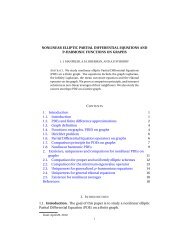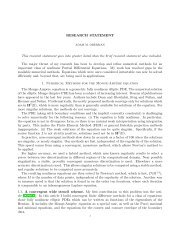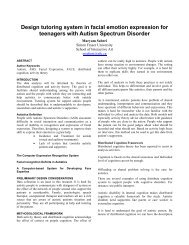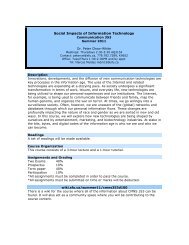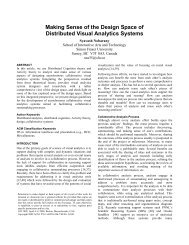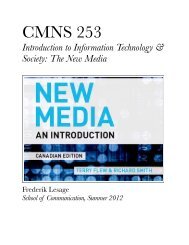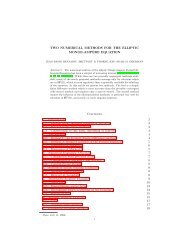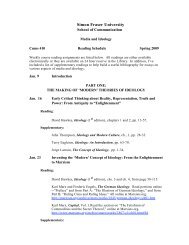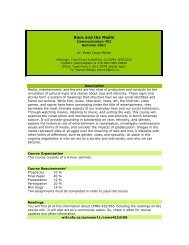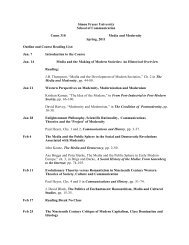CMNS 253 Syllabus - SFU Wiki
CMNS 253 Syllabus - SFU Wiki
CMNS 253 Syllabus - SFU Wiki
Create successful ePaper yourself
Turn your PDF publications into a flip-book with our unique Google optimized e-Paper software.
Today's media enable people to inform, persuade, and influence the beliefs of others and,most important, help them to organize action on all scales. In doing so, people move from theliteracy of participation to the literacy of collaboration.CollaborationUsing the technologies and techniques of attention and participation allows people to worktogether collaboratively in ways that were too difficult or expensive to attempt before the adventof social media. Though collaboration has a slightly different definition from cooperation andcollective action, in general doing things together gives us more power than doing things alone.Collaboration among secondary school students in Chile in 2006 led to the "PenguinRevolution," so called because of the students' black-and-white school uniforms. What started asa relatively small walk-out and protest calling for education reform soon grew as the students,fourteen to seventeen years old, used social media such as text-messaging and YouTube to spreadtheir message. They chained the doors of public schools in Chile and organized rallies with asmany as 800,000 attendees, leading the Chilean government to increase spending on educationand reexamine the country's educational system.[6]But it's not just young people who are collaborating via social media. In January 2007, JimGray, a computer scientist with Microsoft Research, took his sailboat out on San Francisco Baybut did not come back that evening. His friends at Microsoft, Google, Amazon, and elsewherejoined together. They got the latest photos of that area of the ocean from NASA and fromGoogle, and Microsoft engineers divided these into half a million images, which they posted onAmazon's Mechanical Turk. Approximately 12,000 volunteers searched through those half amillion images in a couple of days. Although there is no "look for your missing friend at sea"infrastructure or formula, Gray's friends put together various web technologies and organized aneffort involving thousands of volunteers. Sadly, they never found Jim Gray.[7]Volunteers are also collaborating in response to natural disasters. People always rush intoburning buildings. People always give first aid. But now we are seeing a global emergent collectiveresponse to disasters, before the official emergency responders arrive on the scene. Within hoursof the Asian tsunami, for example, the South-East Asia Earthquake and Tsunami Blog had beenset up.[8] After the Katrina hurricane in the United States dispersed people from New Orleans,their relatives didn't know where they were. The various notices posted on Craigslist, on Usenet,and on half a dozen different sources were consolidated into a uniform database through theKatrinaHelp <strong>Wiki</strong>, implemented by thousands of volunteers.[9]A final example from hundreds that I have identified is Twestival (or Twitter Festival). Thefirst Twestival Global, held in 2009, supported the nonprofit organization charity:water.Approximately 1,000 volunteers and 10,000 donors raised more than $250,000—enough moneyto drill 55 wells in Uganda, Ethiopia, and India, bringing clean water to more than 17,000people. A network of volunteers were mobilized to get things done for the social good withoutgoing through official channels—which moves us toward the next literacy.[10]



